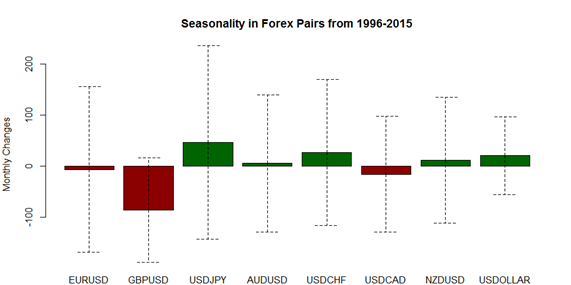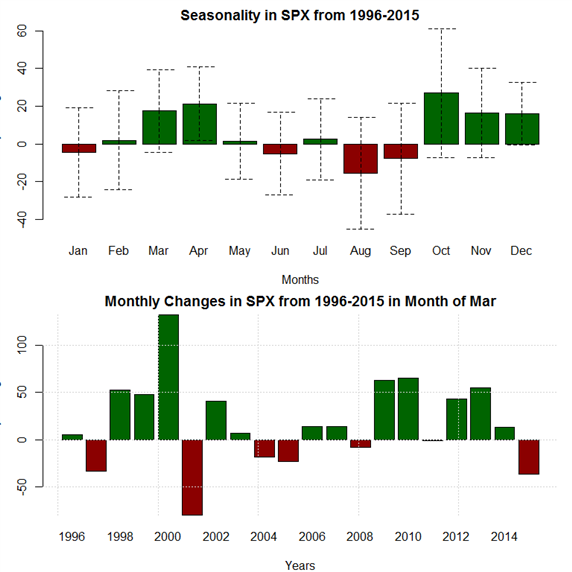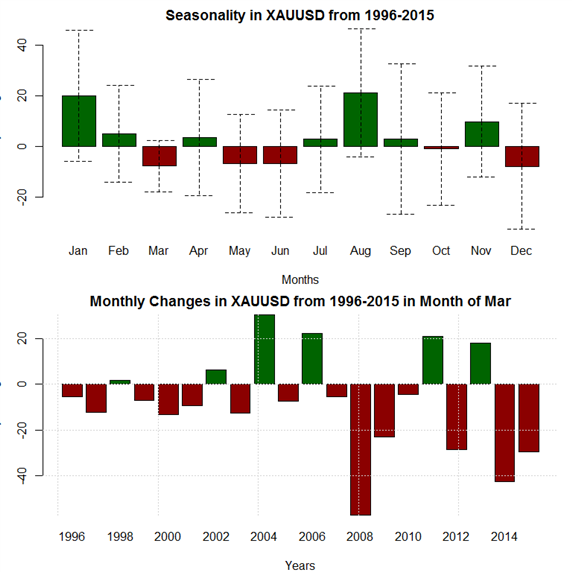Talking Points:
- March marks the third month of the strongest quarter of the year for the US Dollar.
- The commodity currencies have typically fallen flat during March.
- March is the second of four consecutive months of gains for the S&P 500.
See the full rundown of seasonal patterns broken down by currency pairs below, and to receive reports from this analyst, sign up for Christopher’s distribution list.
In what turned out to be a mixed month for the US Dollar, the second-half rebound in February saw the greenback trade closer to its February seasonality forecast. Another choppy month could be ahead. Like February, March seasonality trends favor a slightly stronger USDOLLAR Index, and there is little agreement among the components of the index once again. The cross-market influences of the globally negative news cycle – if it’s regarding the US/Russian proxy war in Syria, refugees pouring into Europe through Turkey, concerns over Chinese economic growth, a potential breakup of the European Union in its current form after a 'Brexit,’or the vicious, populist US presidential election cycle – are bound to persist.
News developments pertaining to FX markets more directly will continue to hold sway as well. Market participants have displayed increasing fragility with respect to central banks’ policy shifts, and with several milestone central bank meetings due ahead – the March 10 ECB meeting and the March 16 FOMC meeting come to mind – it’s likely that, like in February, seasonality trends may not exert their influence until the later part of the month (perhaps correcting exacerbated moves around the mid-month central bank meetings.
For March, as we did in February, we have expanded our focus on the period of 1996 to 2015 in recognition of the evolving relationship between economic data, central banks, and financial markets. The longer observation period captures several crisis events/periods that traders may find analogous to events unfolding today: the Asian crisis; the US tech bubble; the US housing bubble; the global commodity bubble; and previous rate hiking and rate cutting cycles, from the major central banks,during times normal (pre-2008) or extraordinary (post-2008). By increasing the sample size to 20 years, we believe the statistical stability of the estimates will have increased relative to utilizing a shorter time-frame/smaller sample size.
Learn how proper risk management can impact your trading results with the “Traits of Successful Traders” guide.

Forex Seasonality in Euro (via EURUSD)

March is a neutral month for EUR/USD, from a seasonality perspective, due to its inconsistent performance metrics. The pair has depreciated 55% of the time in March over the past 20 years, and its average performance during this time frame is -14-pips per month. Recently, EUR/USD has lost ground in each of the past three years (with its second-largest loss in March over the past 20 years coming in 2015.
Forex Seasonality in British Pound (via GBPUSD)

March is a neutral month for GBP/USD, from a seasonality perspective, due to its inconsistent performance metrics. The pair has appreciated or depreciated 50% of the time in March over the past 20 years, yet its average performance during this time frame is -56-pips per month. Positive years have only produced modest gains, while negative years have produced even steeper losses. Recently, GBP/USD has lost ground in each of the past two years and four of the past six years overall.
Forex Seasonality in Japanese Yen (via USDJPY)

March is a very bullish month for USD/JPY, from a seasonality perspective. The pair has appreciated 65% of the time in March over the past 20 years, and its average performance during this time frame is +101.6-pips per month. Negative years have been infrequent and have only produced modest losses, while positive years have produced relatively larger gains. USD/JPY has rallied in every year since 2009.
Forex Seasonality in Australian Dollar (via AUDUSD)

From a seasonality perspective, February is a neutral month for AUD/USD, due to its inconsistent performance metrics. The pair has appreciated or depreciated 50% of the time in March over the past 20 years, and its average performance during this time frame is a mere +9-pips per month. Recently, AUD/USD has split time up and down over the past four years.
Forex Seasonality in USDOLLAR

From a seasonality perspective, March is a neutral month for the USDOLLAR Index. The index has only appreciated 47% of the time in March over the past 17 years, yet its average performance during this time frame is +20.7-points per month. Recently, the USDOLLAR Index has rallied in three of the past four years during March.
Forex Seasonality in New Zealand Dollar (via NZDUSD)

March is a neutral month, from a seasonality perspective, for NZD/USD. The pair has appreciated 55% of the time in March over the past 20 years, yet its average performance during this time frame is -4-pips per month. While March during the QE era (2009 to 2015) was a period of strength for the NZD/USD (gains in five of the seven years), longer-term, the New Zealand Dollar may find itself biased towards its longer-term tendencies.
Forex Seasonality in Canadian Dollar (via USDCAD)

March is a slightly bearish month for USD/CAD,from a seasonality perspective. The pair has depreciated 70% of the time in March over the past 20 years, but its average performance during this time frame is just -12-pips per month. March during the QE era (2009 to 2015) was a period of weakness for the USD/CAD (losses in five of the seven years), longer-term, and the Canadian Dollar may find itself boosted by the long-term distribution of losses relative to gains.
Forex Seasonality in Swiss Franc (via USDCHF)

From a seasonality perspective, March is a neutral month for USD/CHF, due to its directionless performance metrics. The pair has depreciated 60% of the time in March over the past 20 years, and its average performance during this time frame is slightly positive at +31-pips per month. Positive years have produced gains just large enough in magnitude to offset the equally frequent down years. Recently, USD/CHF has appreciated in each of the past three years, but lost ground in the seven years prior.
Forex Seasonality in S&P 500

March is a bullish month, from a seasonality perspective, for the S&P 500 due to its short-term performance metrics. Recently, the S&P 500 lost ground in March last year, but had rallied in each of the past three years and five of the past seven overall. The index has gained ground 65% of the time in March, and gains have averaged +17.52-points over the past 20 years. Considering that it is widely understood that recent gains may have been driven by expansive central bank monetary policy during the post-GFC/Great Recession years, the S&P 500 is perhaps the most interesting instrument to track compared to its seasonality trends as the Fed attempts to normalize policy.
Forex Seasonality in Gold

From a seasonality perspective, March is a bearish month for Gold. The precious metal has depreciated 70% of the time in February over the past 20 years, and its average performance during this time frame is -$7.90/oz per month. Recent years haven’t been kind to Gold, with losses in each of the past two years and seven of the last nine overall. One outcome that may be observed as well: heightened volatility to the downside. The worst five March performances by Gold over the past 20 years have all occurred since 2008.
Read more: EUR-crosses Slump as Bar for ECB Action is Lowered
--- Written by Christopher Vecchio, Currency Strategist
To contact Christopher Vecchio, e-mail cvecchio@dailyfx.com
Follow him on Twitter at @CVecchioFX
To be added to Christopher’s e-mail distribution list, please fill out this form




